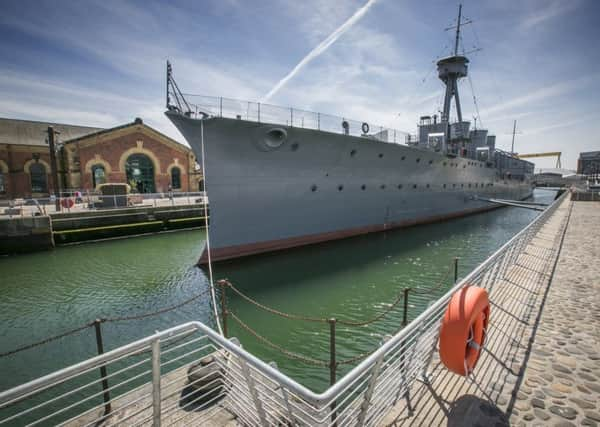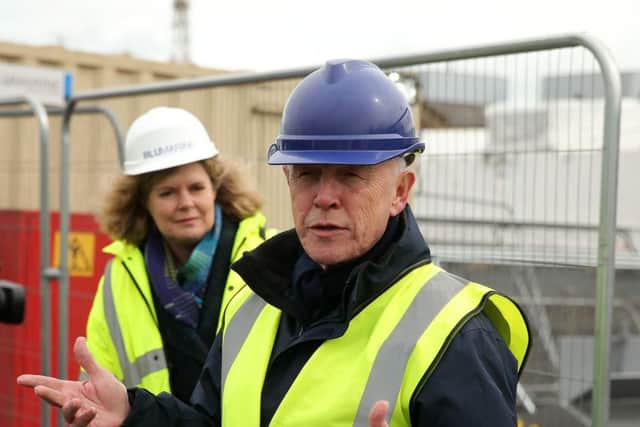Jutland's sole survivor has storyto tell


Centred on HMS Caroline, the sole surviving ship from the World War One battle, the visitor attraction is now up for a National Lottery heritage award ... but less than 10 years ago the ship was destined to be scrapped.
Although the HMS Caroline had been docked in Belfast since 1924 when it was used as the Royal Navy’s headquarters in Belfast – after it was decommissioned in 2011 it looked as though the ship was on its way to Portsmouth.
Advertisement
Hide AdAdvertisement
Hide AdCaptain John Rees OBE, Chief of Staff of the National Museums of the Royal Navy, said: “We’ve known about Caroline for many, many years but knowing about her, and understanding and having an empathy with her is very different.


She came on the National Museums horizon in about 2009 when the Defence Management Board at that time said she no longer had a use for Caroline and she was going to be scrapped.
“We paid a visit and we began to realise what we’d got – Caroline is absolutely unique.
“Never before have we seen a ship with so much original materiality from when she was built.”
Advertisement
Hide AdAdvertisement
Hide AdHMS Caroline was saved when the NI government intervened and announced the ship would remain in Belfast and would be restored thanks to an injection of funding from the National Heritage Memorial Fund.
A further boost came when the Heritage Lottery Fund announced an £845,600 grant to support conversion work as a museum and a further £11.5m to turn HMS Caroline into a visitor attraction in time for centenary commemorations of the 1916 Battle of Jutland.
The final piece of the jigsaw fell into place earlier this year with the completion of a visitor and exhibition centre in the restored pump house and refurbishment of Alexandra Dock.
Captain Rees commented: “Over the past six years, contractors, staff, management and officers have worked tirelessly to restore HMS Caroline to its WW1 glory, and tell the historic story of the Battle of Jutland.
Advertisement
Hide AdAdvertisement
Hide Ad“Caroline was a bit sad and a bit sorry when we took ownership.
“She hadn’t been dry docked for almost 30 years. She’d had no planned repair and maintenance.
“Everything was ad hoc. The decks were rotten, paint was peeling off all over the place.
“She had a story of the Navy and of service and of her location in Belfast that was paramount. What we found as we started to do the adaptation work is so much more of the original Caroline is there.
Advertisement
Hide AdAdvertisement
Hide Ad“The mess decks, the shower rooms, the paint samples, the tiles on the floor – all these things painted a rich picture of her original state and her heritage visitor attraction.
“There is much more to one of the most complete vessels of her time.”
He continued: “We are immeasurably grateful to those who have taken the story of Caroline into their hearts.
“From the visitors who have been intrigued enough to visit her, to the National Lottery and Heritage Lottery Fund for realising her value and enabling a completely new and fascinating heritage tourism asset for Belfast and the whole of the UK.”
Advertisement
Hide AdAdvertisement
Hide AdSince the ship opened as a discovery site, Caroline has welcomed intrepid explorers, curious to know what life was like during The Battle of Jutland, the largest sea battle of the First World War.
The HMS Caroline experience takes the visitor from an immersive ‘Jutland Experience’ on board, and the sights and sounds of the devastation of battle, to historic spaces such as captain’s quarters, mrine’s mess and the heart of the ship; the engine rooms which drove HMS Caroline through the historic war years.
The pump house at Alexandra Dock which opened as a museum earlier this year is home to an extensive visitor and exhibition centre featuring much of the original Edwardian era machinery and technology, medals and artefacts from those who served on board.
Captain Rees, discussing future developments, said: “The Caroline is a world-class museum and heritage visitor attraction.
“There is much of Belfast’s maritime industrial heritage that can be and should be unlocked by further development.”